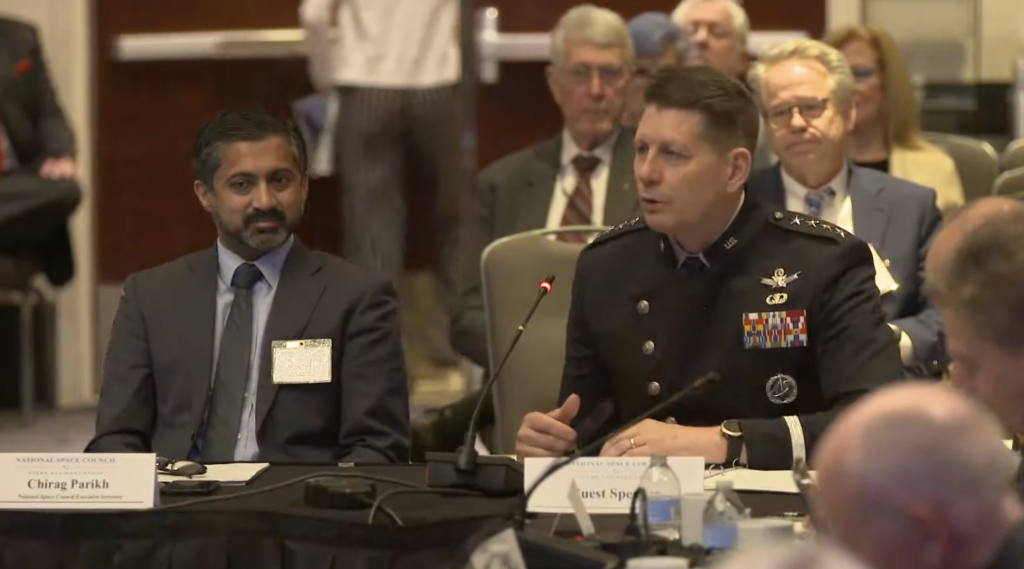
National Space Council Executive Secretary Chirag Parikh (left), Vice Chief of Space Operations Gen. D.T. Thompson, at the first meeting of the council’s User Advisory Group, Feb. 23, 2023.
WASHINGTON — The National Space Council’s new Users Advisory Group (UAG) met for the first time today, with its national security subcommittee focusing largely on how the Pentagon can better take advantage of the booming commercial space sector.
According to the UAG charter [PDF], the body is charged with providing the National Space Council with “advice and recommendations … on matters related to space policy and strategy, including Government policies, laws, regulations, treaties, international instruments, programs, and practices across the civil, commercial, and national security space sectors.”
Today, the UAG heard from Space Force vice chief Gen. D.T. Thompson, who zeroed in on the service’s current and planned integration of commercial products and services.
“In the Space Force, we think about the use of the commercial sector in two ways,” he said. “The first is the direct use of those commercial services to support our operations, our missions, and our activities, buying them as off-the-shelf services that we can use.”
The second way is as a potential provider of new technologies or approaches that the Space Force can adapt or model, Thompson said.
“The commercial sector is now also serving as an engine of innovation, and the technologies that they’re developing, the new and innovative operating concepts, the way they are thinking about space also spurs us on to think about, can we use those technologies and operating concepts … perhaps we can adapt them to some of the military roles and missions,” he said.
Chirag Parikh, the executive secretary of the National Space Council, stressed that the lines between the commercial, civil and national security space sectors are blurrier than ever before as new technologies and space applications as the former sector has burgeoned.
“As we think about the Venn diagram of space, we think about it in the three sectors, civil, commercial and national security. And what’s interesting about that Venn diagram … of civil, commercial, and national security is becoming more and more overlapped,” he said. “And a real reason for that is actually … the value that commercial space services are providing to the economy, it’s providing to our civil capacity, and it’s providing to our national security capacity.”
The UAG has six subcommittees, covering topics that range from safeguarding national security to promoting the US commercial space industry to advancing norms of responsible behavior in space to addressing climate change. Vice President Kamala Harris, who chairs the National Space Council, in December announced the UAG’s 30 members — a list that includes top-level executives of big industry players, such as Lockheed Martin and Blue Origin, as well as small startups, such as Slingshot Aerospace and Astroscale. Harris met with the members at the White House today, following the conclusion of the UAG meeting.
The group further includes scientists and academics with expertise ranging from climate to the ethical implications of new technologies to STEM programs for middle schoolers — Katrina Harden Williams, a teacher at a Iowa middle school, told the group that she would be presenting some ideas from her students on how to clean up space junk.
Space Force chief Gen. Chance Saltzman has already agreed to gather his key staff and meet with those national security subcommittee members who have security clearances, although a date has not been set, retired Air Force Gen. Lester Lyles, who chairs both the subcommittee and the full UAG, said today. He also noted that if Director of the National Reconnaissance Office Chris Scolese cannot attend the meeting with Saltzman, a separate meeting will be put together.
That meetings, he explained, are designed to help the subcommittee narrow down its agenda for the year. “What do we want to focus on?” he said.








